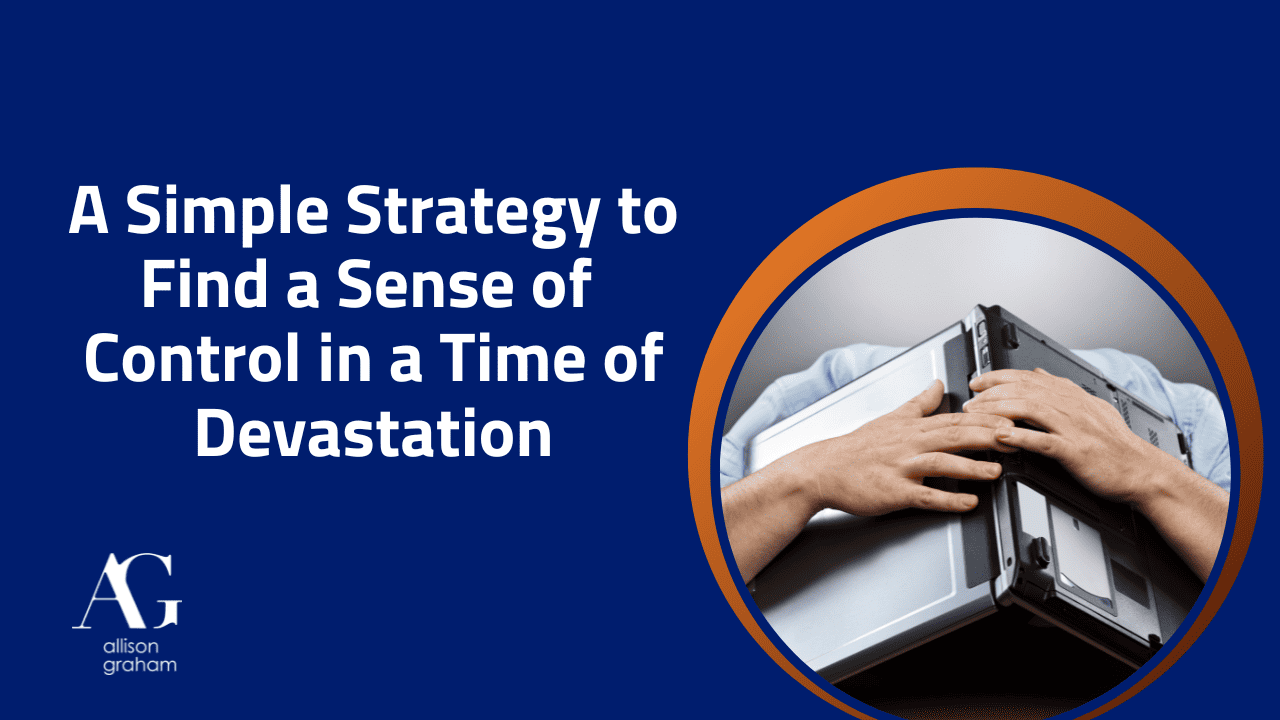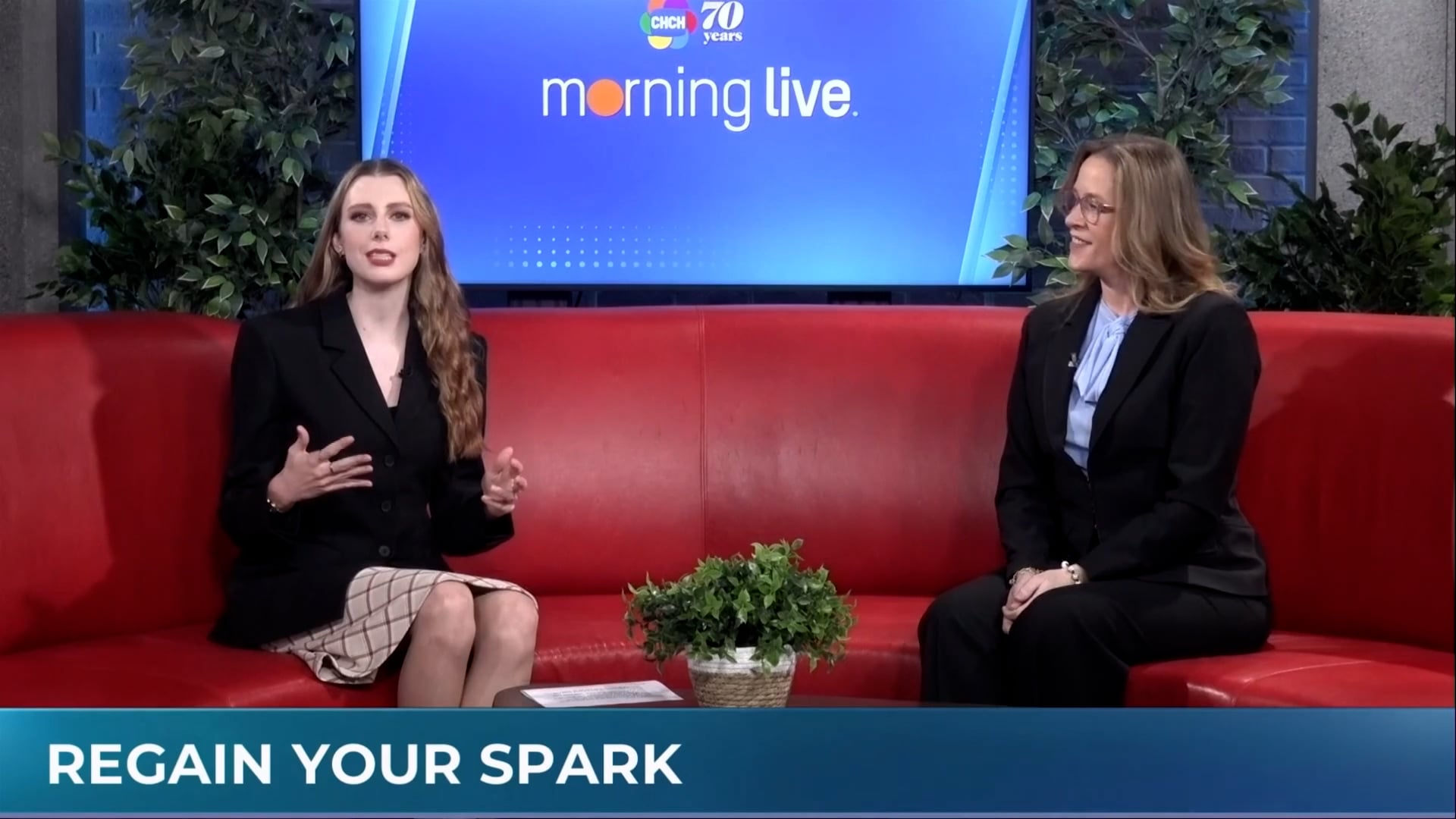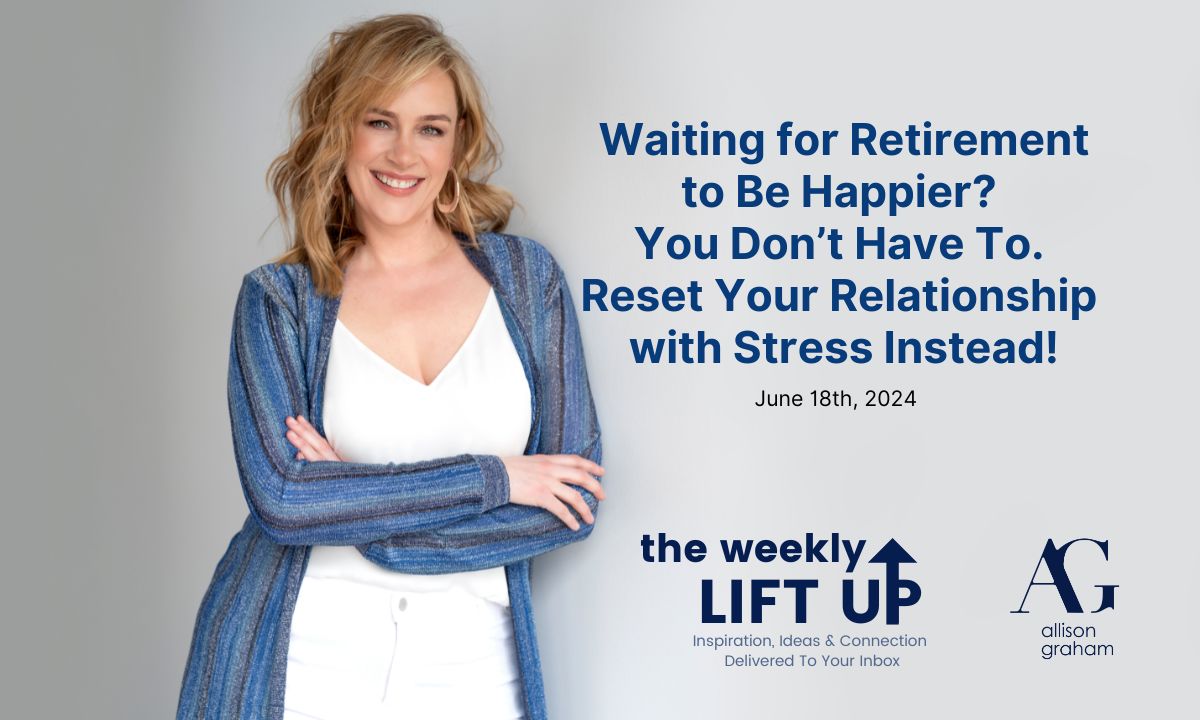When you’re facing a true life adversity – it can be tough to focus and even harder to lead others when you’re struggling yourself. The framework I share in the video is the system I use to help my clients come out of overwhelm and if it’s helpful for you – please embrace it.
transcript (unedited)
Summary
- How to feel a sense of control in difficult situations.0:00
- Allison created this model in 2009 when she was going through a life-changing situation in her own life and has used it in her coaching and training work.
- Get the book.
- The importance of having a sense of control.1:27
- Losing everything in one’s life is a true survival stress situation. There is no way to escape the emotional rollercoaster of what it takes to get through something like this.
- Adversity.
- From every adversity comes new obstacles and obstacles. When looking at them objectively, there is no need to put as much of the emotional intensity of dealing with and healing from the adversity on to the obstacle.
- High level of control, focus on doing the tasks right.
- How to deal with the adversity.5:35
- Denial is a form of denial, and by ignoring it, you’re eventually going to have to deal with it.
- Empowering stress is the kind of stress that helps us get focused and inspired and do our work as efficiently and effectively as possible.
- The ice cube that became the snowman.7:35
- The ice cube that became the snowman is a metaphor for the three things that are barriers to performance, emotion, stories and habits.
- The first step is to understand the emotion and what it actually applies to the adversity, not necessarily the task right now.
- How to neutralize the negative storylines.10:51
- Try to figure out if a word is coming up a lot, neutralize it and come up with two or three more storylines.
- Try to be as neutral as you can around storylines and look at the different habits of different people.
- The natural disaster model, figure out the new obstacles that come from it and the tasks to take to find the solution and implement the solution.
- Allison graham.
Full transcript of video
If you are facing wildfires or other natural disasters and really struggling mentally and emotionally, and trying to figure out how you can deal with all this incredible overwhelming stress, you’re feeling, the model I’m about to share with you is going to give you a way that you can actually feel a sense of control in a situation that is so obviously, outside of your control.
Background of this Framework Came to Be
I created this system in 2009, when I was going through a life altering situation of my own, and I have used it in my coaching and training work. And as a keynote speaker, I use this model with my clients to help them find a way through the most difficult challenges in their life. And so if it works for you, awesome, Please embrace it. If it isn’t for you, then, you know, there are other systems out there.
Stamp of Approval for this Concept
Several months ago, I shared this concept with the head of psychiatry at a prominent medical school. And she said, Allison, this is game changing. So I’m not familiar with this model anywhere in the medical literature. And I can see how it can be very powerful to help people gain perspective on what the challenges are that they’re facing. She really encouraged me to get it out into the marketplace so people could see it. And I’m working on a book with it. And it just as I’m watching these fires unfold, and I have clients, friends and family who are impacted by this. I am, it’s just on my heart to share it.
So forget the book, just give me the information, and I hope it will be helpful for you.
Skip the Platitudes of Dealing with a Crisis
Now you’ll notice in this I am not going to say things like the platitudes that you’re seeing everywhere, like as long as you’re safe, then you know, all your possessions can be replaced. And well, absolutely, that is true, please, let’s not negate the severity of what happens when you actually lose everything in your life. That is your physical possessions, your home your security.
True Survival Stress
This is a true survival stress situation, it doesn’t matter if you’re like great at dealing with stress, like there’s no way you’re escaping the emotional rollercoaster of what it takes to get through something like this. Now, we are resilient, which means that you will go through the grieving process and you as you face this adversity, but where can you feel that sense of control.
Risk to Leaders
And one of the biggest challenges that happens when we face big issues is if you’re in a leadership role, or if your company still needs to operate as you’re going through something in your personal life, then that can be even more overwhelming. And if you’re the leader who has to look after everybody else, then that also can be really overwhelming. And what ends up happening, not happening COVID as well is a lot of people just kept going and going and they never actually processed, the heaviest stuff, which is why so many people ultimately ended up burning out.
The Model: Adversities – Obstacles – Tasks
So let’s hop into the model. Now. It’s very simple. And it will be, I believe, quite intuitive for you. But I essentially we have an adversity and adversity I define as a catastrophic external force that will forever change the way you know your life to be. You can’t escape it, you can’t deny it. Right? It doesn’t matter how good you are at dealing with stress, you have to go through the the like, all of the stress hormones are going to fire it’s a true survival stress situation. And everything in your being is going to fire to say you or someone you love is in danger. Now adversities. Obviously, this fire is one but from every adversity comes new obstacles and obstacles are the things that when we look at them objectively, we don’t necessarily have to put as much of the emotional intensity of dealing with and healing from the adversity.
The Model: Resulting Obstacles
On to the obstacle. The obstacle is something that we need to solve in the situation with the wildfire, perhaps the many obstacles that you have to deal with are the evacuation, which could mean there might be a financial burden, where are you going to stay? How will you get there, right? And then you know, setting up if you do have to work or you know, your team, so maybe there’s medications you need to deal with, it could be anything, right? So what you do is you take the adversity and then you say okay, what are all the obstacles that come out of this.
The Model: TASKS
And then what happens is we have the tasks and the tasks are the things that we need to do to find the solution to the obstacles or to implement the solutions to the obstacles when we start thinking about levels of control, low level of control when it comes to adversities. When it comes to obstacles, we have a medium level of control. And when it comes to the tasks that need to be done, we have a high level of control. And when you look at this, what it does is we focus our effort on doing the tasks, right. So this needs tasks we need to do obstacles we need to solve and adversities we need to heal. So when we think about being empowered If we can take short bursts of energy that are completely focused, then we can do the tasks.
Stuffing Down Emotions
Unfortunately, what ends up happening in our society when we’re feeling these big emotions that we do not want to feel, which is often the adversity stuff that we need to heal from, we tend to get really, really busy and doing the tasks we try to minimize, when people say things like focus on what you can control and ignore the stuff outside of your control, the very thing that makes is going to have the biggest impact on your life is the thing that’s out of your control. It’s the adversity. And so by ignoring it, that’s called denial, eventually, you’re going to have to deal with it. And this is what happens, we as a society are taught to stuff down the hardest stuff, and not actually process it effectively. And then it comes up, because those emotions are gonna go somewhere. So then what it’s going to do is it’s going to roll down, right. And so the obstacles, all of that heavy, heavy, heavy emotion, if we’re not giving ourselves the space and the grace to heal from and process, the severity of the situation, then it’s going to that that of those emotions are going to go somewhere and they’re going to make the obstacles are harder to deal with. And the tasks harder to deal with.
The lowest common denominator of the challenge
When you do this. It’s almost like finding the lowest common denominator of the adversity, we do empowering stress meaning of focus Sprint’s of activity to get the task done, get really crystal clear and organized and exactly what needs to get done. So you can do it in the shortest amount of time possible with the obstacles, we want to be as objective as possible. Alright, I’m gonna draw one more thing for you that’s going to show you how to do that. But with the adversities, we just have to feel it please don’t say to people, like it’s going to be okay, don’t cry, you know what, it’s not okay. is awful, it sucks, and denying that is disrespecting the severity of what you’re going through. And so I know it try people try to make people feel better, like at least you’re safe, etc.
The different types of stress: Survival, Empowering, Destructive Stress
It’s an adversity, it will forever change the way you know your life to be. If you honor that, yes, you can heal from it. But you’re gonna have to go through the grief process. This is survival stress. I also mentioned empowering stress. And empowering stress is the kind of stress that helps us get focused and inspired, and do our work as efficiently and effectively as possible. And there’s a third kind of stress that I’m going to draw out for you as destructive stress.
The Ice Cube that became the snowman
And it’s the patterns that can actually make life harder than it needs to be when we’re already facing a really, really difficult situation. And for this, I have to share with you the ice cube that became the snowman, let’s say everything you need to do all of those tasks, and all of those obstacles that you need to solve are ice cubes. And your job is to melt them as efficiently and effectively as possible. Now, as part of the human experience, we just don’t do that. Right, we also have access to a whole great big pile of snow. And the snow is represented by three things, emotion stories, and habits or the way that we are I call them barriers to performance. Okay? Unfortunately, storylines tend to default to negative and emotions often are misplaced. So if we don’t deal with the true adversity, the emotion with the adversity, it’s got to go somewhere. And so it often will be overshadowed. And this is how we see a lot of people like blowing up in road rage incidents, because it gets wrapped around the tasks and the obstacles instead of being effectively processed in relation to the adversity, so often most plays negative and these habits are often unhealthy. So what do we do with this, if you think about like, how much effort it’s going to take you to melt that ice cube, do that task, solve that obstacle, when you add all the snow around it? What ends up happening is it takes you still just have to melt the ice cube. But now you got to melt all the snow to go with it.
Using the Metaphor
And so this idea around turning ice cubes into snowman has been just something a metaphor that I came up with years ago and my clients love it. And we just started to talk about like, Hey, are you making this harder than it needs to be as in Are you turning an ice cube into a snowman?
Feeling the Emotional Intensity
And so what do we do? Well, first of all, with the emotion, understand the emotion and what it actually applies to. Okay, so it applies to the adversity, not necessarily to the task right now. That’s a deeper conversation. Probably can’t really cover it because that’s like applying the right emotion to the right thing and compartmentalizing emotions and yeah, anyway, let’s not get too deep.
Easiest Starting Point
But the easiest thing you can do is to look at these negative storylines because when something is negative, and we add negativity to the task, then it just makes it harder to deal with. Now I am not of the opinion that we should go with the positive storyline. So let’s say over here is like doom and gloom storyline. And over here is like magic fairy dust and rainbows and unicorns and like totally Pollyanna, awesome positive, not going to help you. All I’m asking for you to do when you’re in a crisis situation is to neutralize the storyline. And so somewhere in the middle is neutral doesn’t need to be positive. But if we only look at the doom and gloom, then that snowman that that pile of snow can be more intensive to be even harder to melt. So when you start talking about the situation, what are the alternatives? Watch the languaging? What are the extreme words you’re using? Are there ways that you could neutralize it, because the words you use are going to influence how you feel. And we already know the situation is dire. So we want to be sure that we’re not getting into the rabbit hole of extra extra extra negative or denial. So just try to figure out like, if somebody if you notice a word is coming up a lot, can you neutralize that word, and maybe even give two or three more storylines.
No Judgment Required
And one of the things when you start looking at other people how they’re dealing with a difficult situation, this is not a time for judgment, this is not a time for accusations, or interpreting people’s intent in a negative way, just want to try to be as neutral as you can around storylines. And then looking at the different habits. I mean, obviously, that’s a long term thing that we want to try to stack on and deal with.
Avoid Complaining (My vice!)
But let’s say you have a tendency already to be a complainer, right? Like, I know, it’s kind of one of my things like I if I’m not careful, and I’m not watching how I’m dealing with ice cubes and snowman, and I’m facing a difficult situation, it’s really easy for me to go into the complaining mode. And so when I start recognizing it, it’s like, that’s not doing any good. So instead of complaining, can I just neutralize that a little bit, or whatever, like, maybe you say it once and not over and over and over again. Or if somebody else is complaining, you don’t pile on and go, Oh, my God, I know. Like, the situation is awful. And we want to get back through it as best as you possibly can. In life, not just in chaos or crisis.
Summary and Next Steps of the Ice Cube that Became the Snowman
This ice cube that became a snowman is how we ended up making life harder than it needs to be. We want to look at where are the emotions? Where do they really need to be applied? And what are they in relation to. So it’s okay, if you’re scared, it’s okay, if you feel overwhelmed, or anything like that. But if you have to make a phone call to an airline, or to a family member or something, and you are taking out all of that heavy, heavy emotion on that task, that’s when we start to get into trouble and make things harder. And then the negative storylines, just neutralizing them. And coming up with two alternatives instead of just one. If you only give it one other storyline and you go negative to positive, what ends up happening is you your brain, if it’s already bent towards negative was going to be like no. So instead you give up two or three, you’ve got to give it like at least two alternatives to the negative storyline. And then that way, it’s like kind of confused and your mind can like release some of the connection to the negative storyline. And then the habits just be aware of what it is that you’re doing. And if there’s a way that you could just interrupt that pattern a little bit faster, I think that will be quite helpful. So essentially, take the adversity, which is the natural disaster, figure out what are all the new obstacles that come from it from those obstacles, what are the tasks you need to take to find the solution. And to implement the solution, feel very empowered by those tasks, you have a high level of control, set a timer, do them as efficiently and effectively as possible, without having negative storyline around the tasks without adding extra emotional angst around the tasks. And without putting any barriers to performance, like extra worry about detachment about how you’re doing it, or how somebody else should be doing it expectations. And there’s a huge list of barriers to performance that I have in my one book and online and all of that. So if you want that, definitely send me a note and I will get you access to that list, as well. But then with those obstacles, just get into solution mode, being objective, right? We know they’re going to happen. It’s unfortunate, you’ve got to solve them as quickly as you can. And then make time to actually heal and protest and recognize the adversity.
My hope for you
I hope that’s really helpful for you. And if you are affected by this or have loved one to our as well. My heart goes out to you and I know it sucks, but hopefully this model can help you feel a little bit more empowered and have a little bit more control and a time that’s completely out of your control. Hi, I’m Allison Graham and definitely check out my website and follow along if you want some more tips and tricks about getting through life and stop making life harder than it actually needs to be because it can already be Pretty hard








